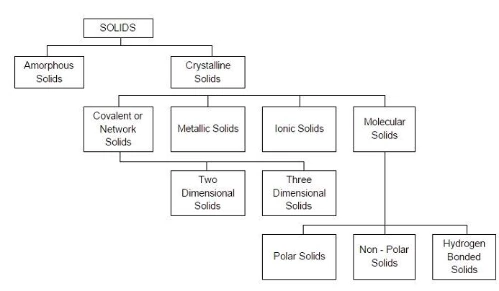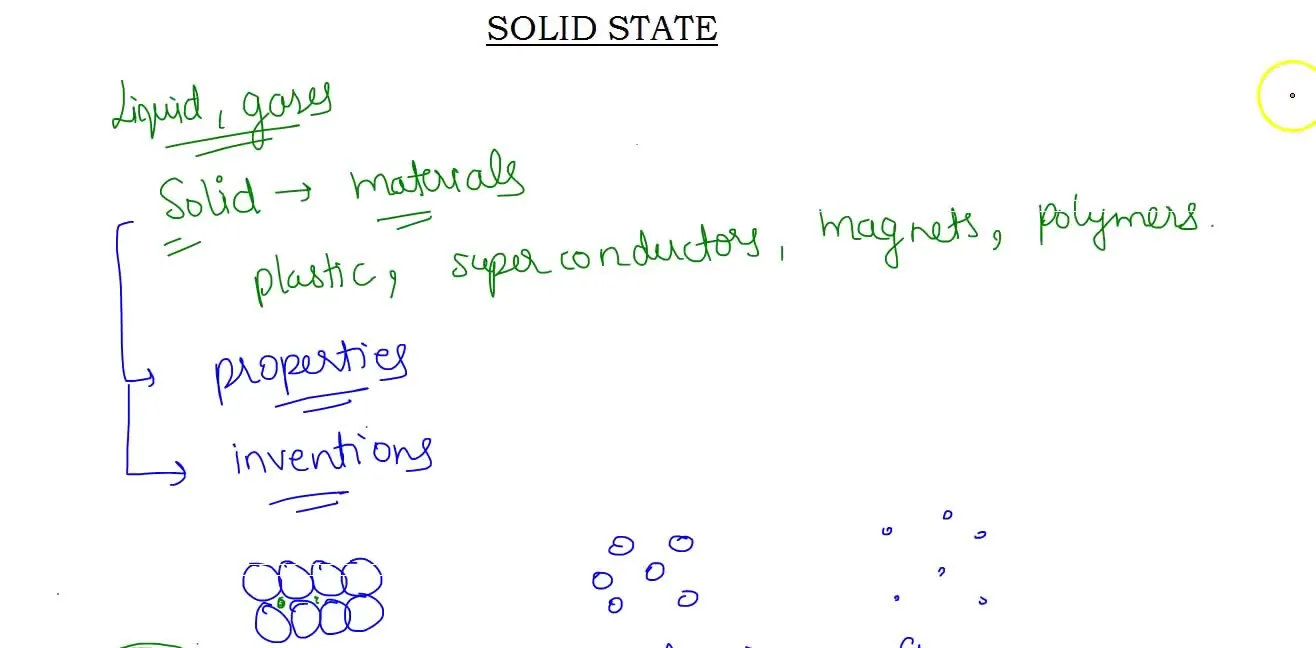CHARACTERISTICS, AMORPHOUS AND CRYSTALLINE SOLID
Amorphous and Crystalline Solids
In this lesson will discuss amorphous and crystalline solids. A solid interface is a small number of atomic layers where two solids are separated with close proximity to one another. Regarding their properties, it differs from the bulk material. Solids are classified into the following categories based on their crystal structures. They are:
- Crystalline solids
- Amorphous solids
It should be noted that the classification of crystalline solids is further carried out into ionic, molecular, metallic, and covalent solids. We will provide a brief explanation of the classification of solids.
Solids are classified into Amorphous solid and Crystalline solids. There are also covalent or network solids, metallic solids, ionic solids, and molecular solids. Here, covalent or network solids are further classified into two dimensions solids and three dimensional solids.
Molecular solids are further classified into polar solids, non-polar solids, and hydrogen-bonded solids. Let us represent this with the help of an illustration:
 (Classification of Solids – Crystalline and Amorphous Solids)
(Classification of Solids – Crystalline and Amorphous Solids)
Crystalline solids
A Crystalline solid or crystal is a solid material that features highly ordered arrangements of their particles such as atoms, molecules, and ions. For example, quartz, diamonds, etc.
Amorphous solids
Amorphous solids are those particles that are not arranged utilizing any specific order. It also lacks the long-range order characteristic of a crystal. For example, plastic, glass, etc.
Pseudo Solids
These are those that considered being solid although they resemble liquid. They are also known as super liquids where they flow slowly at room temperature. For example, glass.
Crystallites
The possession of the short order by amorphous solids makes it possible for the small parts of the amorphous solid to be crystalline, and the rest may be non-crystalline. So, those crystalline parts of the amorphous solids are known as crystallites.
Related Videos:
- Characteristics, Amorphous And Crystalline Solid
- D/W Crystalline solids and Amorphous solids
- Give examples of (1) Crystalline solids (2) Amorphous solids
- Out of crystalline and amorphous solids, which can be cleaved easily?
Now, we will find the differences between Crystalline solids and Amorphous solids:
Crystalline solids
Amorphous solids
Crystals have regular and definite geometry that have long and short-range order of constituent particles.
It does not have any definite geometry, and the particles are irregularly arranged which have short-range order.
It has got high melting points.
It does not have sharp melting points.
When crystal external forms are formed, it possesses regularity.
When these amorphous solids are formed, there is no external regularity in their form.
After cleavage with a knife, it gives a clean surface.
The irregular cut is exhibited by the amorphous solids.
It has got definite heat of fusion.
It does not possess any sort of heat of fusion.
Crystalline solids prove to be very rigid where mild distorting force cannot deform their molecules.
It also does not exhibit rigidity. With the help of bending or compressing, deformation can be done.
It is considered to be as true solid.
They are considered to be supercooled liquids or in other terms called pseudo solids
It displays anisotropism.
It displays isotropism.
Question 1: Which of the following in an amorphous solid?
(a) Graphite (C) (b) Quartz Glass (SiO2)
(c) Chrome alum (d) Silicon carbide(SiCs)
Answer: (b) Quartz Glass is an amorphous solid because of its short-range order of constituent particles.
Question 2: Which of the following is not related to amorphous solids?
(a) They do not have sharp melting points
(b) They are rigid and hard
(c) They are not bound by plane surfaces
(d) They give diffraction bands
Answer: (d) is not true related to amorphous solids. This is because of the absence of long-range order in them and for this reason arrangement is found to be irregular in all directions.
Important Chapters:
 (Classification of Solids – Crystalline and Amorphous Solids)
(Classification of Solids – Crystalline and Amorphous Solids)Crystalline solids
Amorphous solids
Crystals have regular and definite geometry that have long and short-range order of constituent particles.
It does not have any definite geometry, and the particles are irregularly arranged which have short-range order.
It has got high melting points.
It does not have sharp melting points.
When crystal external forms are formed, it possesses regularity.
When these amorphous solids are formed, there is no external regularity in their form.
After cleavage with a knife, it gives a clean surface.
The irregular cut is exhibited by the amorphous solids.
It has got definite heat of fusion.
It does not possess any sort of heat of fusion.
Crystalline solids prove to be very rigid where mild distorting force cannot deform their molecules.
It also does not exhibit rigidity. With the help of bending or compressing, deformation can be done.
It is considered to be as true solid.
They are considered to be supercooled liquids or in other terms called pseudo solids
It displays anisotropism.
It displays isotropism.
Similar Questions
Classify the following solids into amorphous or crystalline solids.
Bakelite, Platinum , Camphor , Oxalic acid , Melamine formaldehyde, Alum , Neoprene, Sugar , Solid CO2 , Polythene.View SolutionSTATEMENT -1 : Amorphous solids are isotrophic
STATEMENT -2 : Amorphous solids lack a regular three-dimensional arrangement of atoms.View SolutionCrystalline and Amorphous Solids || Types OF Crystalline Solids || Lattice and Unit Cell || Bravais Lattices
View SolutionIntroduction OF Amorphous & Crystalline Solids || Types OF Crystalline Solids || Crystal Lattice & Unit Cell || Types OF Unit Cell & Bravias Lattices
View SolutionProperties Of Solid|Crystalline Solids|Amorphous Solids|7 Types Of crystal System|Knowledge About Cube|Simple Cubic Unit Cell|Summary
View SolutionTypes OF Solid (Crystalline and Amorphous),Types OF Crystalline Solid (Ionic,Metallic,Covalent,Molecular)|| General Terms - Space Lattice,Crystal Lattice,Unit Cell,Types OF Unit Cell
View SolutionClassification Of Solids -Arrangement Of Constituent Particles|Pseudo Solids Or Supercooled Liquids|Isotropy And Anisotropy |Types Of Crystalline Solids |Crystal Lattice & Characteristics |Unit Cell |Summary
View SolutionCrysyalline and Amorphous Solids | Types of Crystalline Solids
View SolutionCrystalline solids and Amorphous solids.
View SolutionAssertion (A) : Solids have definite mass, volume and shape.
Reason (R) : Solids can be classified as crystalline and amorphous.View Solution


